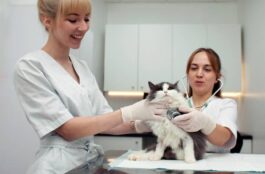Humans appear to be drawn to chubby creatures, whether plump babies or overweight pets. However, as dogs and their owners grow older, the health consequences of being overweight can be far from charming. What are the risks of dog weight gain? What are some of the most common causes of weight gain? And when should you consult a veterinarian about your overweight pet?
How to Determine Whether Your Dog Is Obese
People have different guidelines, but determining if your dog is overweight or obese is a question of both appearance and touch. When you press your dog’s sides, you should be able to feel her ribs. Several dog-food producers offer canine body-condition charts to help you to learn more and evaluate whether your dog needs to lose a few pounds.
Obesity-Related Health Issues in Dogs
Numerous diseases and disorders are associated with excess weight. These include the following:
- High blood pressure
- Type 2 diabetes
- Heart and Respiratory Disease
- Osteoarthritis
- Orthopedic problems
- Skin disease
- Life expectancy decrease (up to 2.5 years)
What should you do if your dog requires a diet?
As with humans, there are a few time-tested techniques for losing weight. To begin, consult your veterinarian to ensure that an underlying health problem or disease does not cause excess weight. Before changing your dog’s food or calories, you should have your dog checked out by a Stockton vet and talk to them about the best options. After following these steps, consider the following useful tips:
Meal Recording
Keeping a food diary is critical for any human weight-loss regimen. Because dogs cannot write, you will have to do it for them. Utilize a measuring cup to keep track of the amount of kibble you are feeding.
Create a Meal Schedule
If you free-feed, leaving food out throughout the day, establish a schedule for meals. Place the food down for a specified period, perhaps 15 minutes, and collect any food that the dog does not consume.
Limit Between-Meal Snacks
In addition to their regular chow, dogs consume many calories. These can range from training goodies to a biscuit that a friendly neighbor slips over the fence. Those calories accumulate. Determine the source of the extras and keep an eye on how many treats the dog is receiving.
Select Low-Calorie Goodies
Many store-bought treats, particularly biscuits, are high in calories. The same is true of chews. Certain dogs will be equally content with fruits or vegetables, such as bananas, carrots, green beans, and apple slices.
Make Sure Your Dog Gets Enough Exercise
Your dog’s health will improve dramatically if you take him for daily walks, and he will burn more calories if he engages in regular playtime rather than being a puppy couch potato. Furthermore, keeping them occupied keeps them from being bored. This has a positive impact on their overall quality of life and their metabolism. Visit this page to learn more on how to make your dog feel good inside and out.
Conclusion
Obesity causes issues that affect practically every system in the body. Obese dogs have higher anesthetic risks and medical costs, even with no visible indicators. Excess weight is simpler to prevent than to treat, so maintaining a healthy weight for the rest of your dog’s life can keep them healthier, happier and help them live longer lives.


